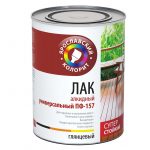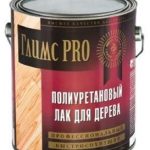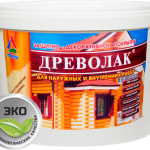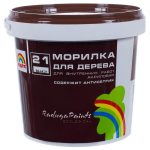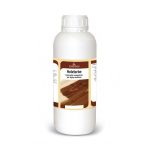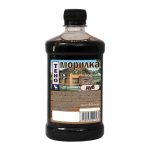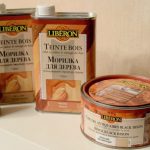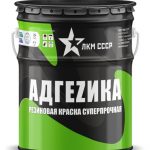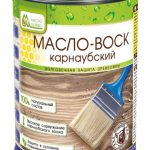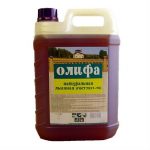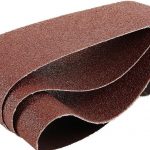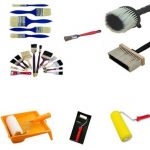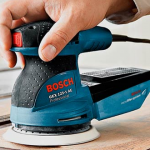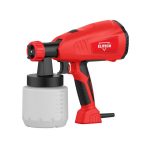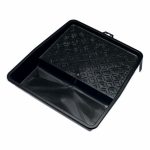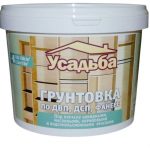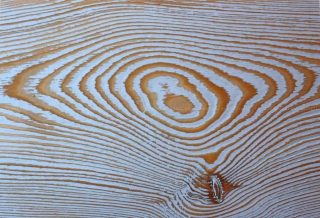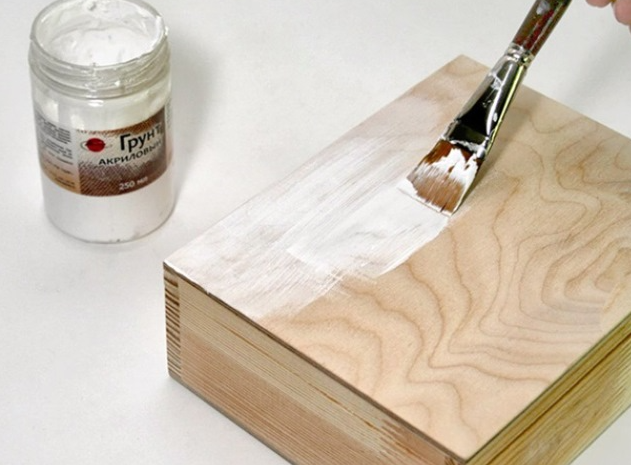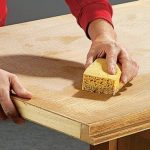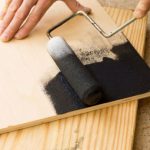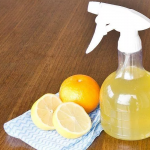Plywood is a material for finishing walls, floors, ceilings. A wide variety of furniture and large children's toys are made from it. Although plywood is quite attractive, has a beautiful wood structure and natural color, it is often necessary to paint, whiten or add some shade.
- What composition to choose for decorative processing of plywood
- Paints
- Lucky
- Stains
- Other formulations
- What you need to protect the material from
- Preparation for painting
- Required tools and materials
- Cleaning and sanding plywood
- Primer
- Requirements for working with paint and varnish mixtures
- Painting process
- How to properly cover
- Imitation wood
- Features of painting in white
- Drying
- Practical advice
What composition to choose for decorative processing of plywood
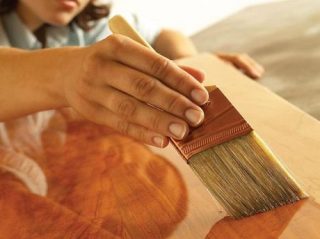
You can paint plywood different compositions. However, they should be chosen taking into account their user characteristics.
- Operating conditions - if a damp room is trimmed with sheets, it is better to take waterproof paint. This emulsion has good hiding power and is resistant to temperature changes. The coating can be washed and wiped with a damp sponge.
- Material type - plywood sheets are glued together with different compositions. The latter influence the choice of paint. If the material contains formaldehyde, it is preferable to use facade paints. If casein based glue is used, the colorant must be oil based.
- Decorative effect - formulations like emulsion or enamel create an even, uniform layer. It is opaque, and the woody pattern disappears completely. Stains or clear varnishes only give a different shade to the wood, while the specific texture remains visible.
- Workload - affects not so much the composition as the choice of the instrument. However, this also matters for the choice of paint. It is not very profitable and convenient to paint a large surface with enamel.
- Interior style - sometimes the shade and texture of the material are incompatible with the rest of the finish.
Often, when decorative processing of plywood, coloring and finishing compounds are combined. Plywood can be painted first and then varnished.
Furniture plywood is painted only with water-based mixtures.
Paints
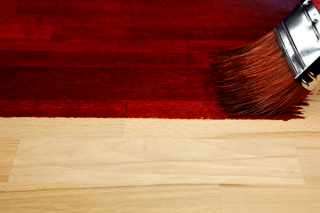
Plywood paint is used in the following types.
- Alkyd - waterproof composition with high covering ability. Forms a dense thick film impermeable to water and steam. The coating is difficult to scratch and can be repaired and repaired if necessary. Alkyd paints smell strong, so they are usually used outside the home. It is recommended to use enamels for painting plywood with erasable lamination.
- Water-dispersive - acrylic, silicone, latex and all other water-based compositions. They do not protect so well from the action of water, being water-soluble, they dry for a long time. However, such formulations are completely safe, do not smell. Used for interior decoration.

Lucky
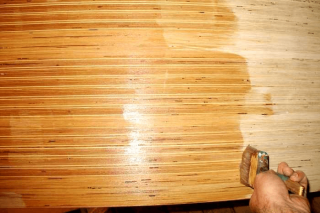
If they want to preserve the interesting structure of plywood during finishing, they use transparent or tint compositions - varnishes.They create a thinner film that is not resistant to mechanical damage, but beautiful and waterproof.
Varnishes are chosen depending on the nature of the work and the operating conditions.
- Nitrocellulose mixtures - waterproof durable varnishes. They dry quickly, but smell strong and harsh, and when dry they acquire a yellowish tint. Usually used for external work.
- Acrylic - water-based varnish with high resistance to temperature changes. Even surfaces located next to heating devices are treated with acrylic varnish.
- Polyester - quickly polymerize and dry. They often create a beautiful glossy shine.
- Composition based on epoxy resin - has a characteristic amber shade and beautifully sets off the texture. A special hardener is added to the mixture, which imparts density and hardness to the coating. Applicable only for interior work.
- Polyurethane varnishes - have the highest cold resistance. Waterproof, dry quickly. Structures subject to the highest stress are covered with polyurethane varnish.
- Water soluble varnishes - silicone, latex, slightly resistant to water and steam. Suitable for varnishing furniture or furnishings in living quarters.
- Oil compounds - impregnate the top layer of plywood, reliably protecting against water and mechanical damage. Such mixtures dry for a long time, but they also serve for a long time. The best option for covering floors.
Varnishes are also distinguished by their decor. They can create matte, glossy, shiny surfaces. Often, compositions with sparkles and colored particles are used to decorate children's furniture.
Stains
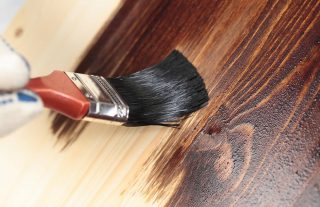
Tinted plywood sometimes looks more interesting than varnished plywood. Finish with the help of special compounds - wood stains. This mixture is absorbed into the top layer of the material, and does not form a film. Thus, the tree is protected from moisture and steam, but remains vapor-permeable.
Stains give plywood shine, noble appearance and a certain shade. Tinted with the following mixtures.
- Water - has a rich color gamut and different gloss. It is purely decorative and can be easily washed off with water.
- Alcohol - protects against ultraviolet radiation and water. Dries quickly and prevents swelling of the top layer of the wood.
- Oil - based on drying oil or other oils. The stain absorbs into the top layer to form a waterproof coating. Available in a wide variety of shades.
- Acrylic - dries quickly, easily adheres even to a textured surface.
- Wax - includes beeswax. The layer created by such a stain is more dense and waterproof. Gives the plywood a beautiful silky sheen. The coverage needs to be renewed.
When using stains, coniferous plywood must be degummed.
Other formulations
Rubber paint - based on latex components. Forms a waterproof coating that is air permeable, but has a high hiding power. Rubber paint is resistant to mechanical damage, therefore it is often used for flooring.
For finishing plywood, you can take oils for wood, but always with hardeners. The veneer layer in the plywood is rather thin, and the oil dries for a long time. It is better to take mixtures with an accelerated drying time.
For the floor, they often use heated drying oil... The composition is applied in several layers, each time waiting for complete absorption. This protection is very reliable.
Powder paint cannot be used to paint plywood. It absorbs moisture, including from the wood itself, which leads to deformation of the material.
What you need to protect the material from
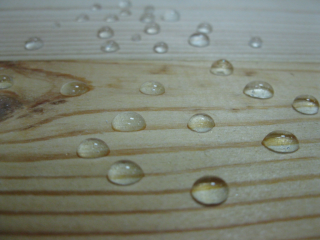
Plywood is painted not only to make the material attractive, but also for other reasons.
- A layer of varnish or paint forms a thin moisture-resistant film. He warns contact of plywood with water.
- Almost all formulations have an antiseptic effect and do not allow fungi to multiply.
- Some of the materials are absorbed by the top layer of the plywood, creating more defense in depth.
- Compounds protect the tree from scratches, chips and other minor damages.
Preparation for painting
In order for paint, varnish or oil impregnation to lie in an even layer, the plywood must be prepared. The technologies are simple and affordable.
Required tools and materials
The following tools and materials are used for staining:
- sandpaper with different grain sizes;
- grinder, if the area of the treated surface is large;
- sponges, paint roller, brushes;
- spray gun, if there is a large amount of work;
- containers for liquids.
A primer is also required for painting. If a damp room is finished with plywood, antiseptic impregnations are also used.
Cleaning and sanding plywood
The surface of premium plywood does not need sanding. But if the material is below grade 2, preparation is needed... Such sheets are cleaned of dust and dirt and sanded with paper # 80. Grind the material perpendicular to the wood fibers - it is necessary. The ends and corners are also sanded.
If a defect is found during sanding - cracks, chips, dents, they are sealed with putty, and then sanded again.
Primer
The primer is applied to level the surface of the plywood and improve the adhesion of the material to the paint composition. The mixture is taken with an antiseptic effect. Apply a layer with a poppy brush or spray. Painting is performed after the soil has completely dried.
Requirements for working with paint and varnish mixtures
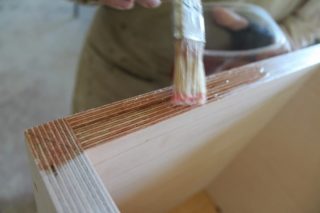
When painting or varnishing, the following requirements must be met.
- When painting a large surface - walls, ceilings - the furniture and floor are covered with plastic wrap.
- Putty, if required, is selected in the appropriate shade. Otherwise, the sealed areas show through.
- The formulations are applied in a thin layer to prevent smudges.
- When using paints and varnishes with a strong odor, work is performed in a protective mask or respirator.
It is advisable to wear protective gloves and an apron.
Painting process
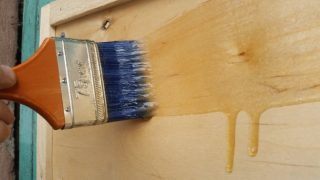
Dyeing plywood is not difficult. It is important to follow the guidelines.
- For a large area, it is better to take a spray gun. If the surface to be painted is small, use brushes or rollers.
- Dilute the paint just before the procedure. If the composition dries quickly, make a minimum portion.
- Any paints and varnishes are applied only along the wood fibers.
- If a more intense shade is required, apply in several layers, waiting for the previous one to dry.
It is impossible to apply a thick layer at once: the paint will harden unevenly, flow, and bubbles form.
How to properly cover
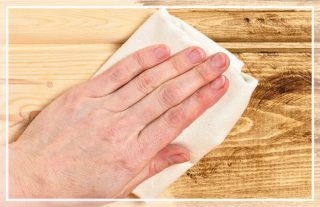
There are several options for applying paint and varnish. Choose a method depending on the viscosity and hiding power of the composition.
- Wax stains or oil mixtures are best applied by rubbing. A portion of the composition is poured onto the surface and carefully spread with a sponge or roller.
- The paint is best applied from a can. This gives a very even thin layer.
- A foam roller is used when applying liquid formulations of low hiding power. This avoids divorce.
- With a paintbrush, thick paints and stains are applied to obtain a rich shade and emphasize the structure.
If the oil stain is applied in several layers, after the first one dries, you need to sand the surface to remove the raised pile.
Imitation wood
- The sheet is painted in the selected color, strokes are applied randomly in different directions.
- After drying with a paraffin candle, wipe the sheet in the same way - in random or selected places.
- A second layer of paint is applied - a matching or contrasting shade. The plywood is coated evenly.
- Until the paint has dried, wipe off the layer with a rag.In areas where there was wax, it is easily erased, on others it remains.
You can apply 3 layers of paint or varnish the plywood after drying. It turns out to be a very interesting structure.
Features of painting in white
Even with high hiding power of the paint getting pure white is difficult... Plywood is prepared for this: primed with white mixtures and sanded. To cover take matte paints, since glossy ones do not hide, but highlight the slightest surface and color defects.
Drying
Plywood drying is a preliminary stage of work. Performed if you need to paint or varnish material brought from the cold. The sheets are placed in the room where they will be used and kept for about a day. If the material was stored or transported at a temperature difference of more than 10-15 ° C, it will take 3 days.
Painted plywood dries naturally. Hair dryer is not used.
Practical advice
When painting plywood and subsequent use, the following recommendations should be observed.
- For work, rollers are often used. Foam rollers should be chosen, since fur leaves leave villi, which are very difficult to get rid of.
- If the plywood is painted or varnished twice, it is important to ensure that the previous layer is completely dry.
- The edges and curved elements are painted with a brush.
- Painted dry surfaces can be cleaned with soft sponges using soapy compounds.
- Glossy surfaces are periodically wiped with a mixture of water, vinegar and lemon juice to renew the shine.
- Do not use abrasive products or hard brushes to clean painted plywood.

